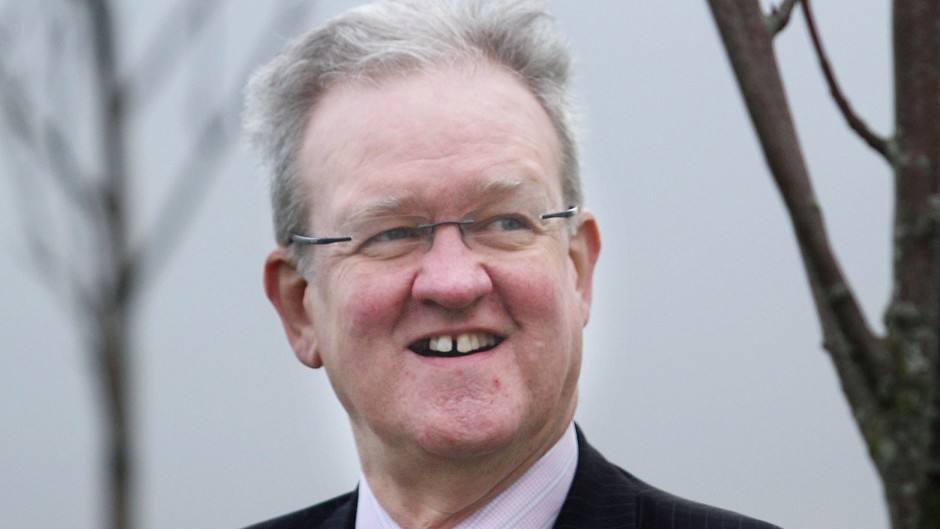Former transport minister Stewart Stevenson has called for the speed limit on all Scotland’s roads to be cut by 10mph to “save the planet”.
The north-east SNP MSP believes the move could help tackle climate change and save drivers money.
But last night motoring organisations branded it a “recipe for confusion” which could cost businesses “millions of pounds”.
Mr Stevenson quit as transport minister in the wake of snowstorms which paralysed much of Scotland in December 2010 after being criticised for his handling of the crisis.
But he returned to then-first minister Alex Salmond’s government as environment and climate change minister the following year.
The Banffshire and Buchan Coast MSP admitted yesterday that his suggestion – which would lower the limit on motorways and dual carriageways to 60mph, 50mph on A-class roads and 20mph in built-up areas – would not be popular with car owners.
But he claimed it would not cost much to implement, and insisted research into the potential benefits must be carried out.
Mr Stevenson said: “The big thing that we should and could contemplate is reducing the speed limits in Scotland, wherever they are, by 10mph.
“It would cost almost nothing to do.
“It would not be popular, but it is one of the proposals that we must get on the agenda, and I encourage people to think about it seriously.”
He said the issue should be examined so evidence was available when the policy was being considered.
“For private vehicles this would save money, cost little to implement and be better for the environment,” he added.
“However, with HGVs, increasing the speed limit actually improves fuel economy, so this would not apply to them.”
Mr Stevenson said his proposal was consistent with the government decision to increase the speed limit for heavy goods vehicles on the A9 between Inverness and Perth.
He made his comments during a Holyrood debate yesterday supporting WWF’s Earth Hour 2015.
A spokesman for the Scottish Green Party said it was hard to take Mr Stevenson’s suggestion seriously, because the Scottish Government spent less than 2% of its transport budget on cycling and walking while expanding the road network and pursuing the growth of air travel.
Chief Superintendent Iain Murray, head of road policing in Scotland, said road safety was a “priority issue” and the force was happy to contribute to the debate.
Neil Greig, the Institute of Advanced Motorists’ director of policy and research, said: “A blanket approach like this does not have our support.
“There is no real evidence that reducing limits on perfectly safe roads will be effective.
“It would be far better to target limited resources at those locations with a known speed-related accident problem.”
A spokesman for the AA said it was not persuaded by the idea of a blanket reduction, and routes should be examined on a case-by-case basis.
“A blanket drop would cost businesses millions of pounds because it will reduce their efficiency and there are other cost-effective ways to reduce traffic, particularly in cities,” he added.
“An alternative would be for people to leave their cars outside cities and towns and use public transport to get in and out.”
The Scottish Government has said it favoured a more targeted approach to speed limit reduction.
A spokesman said the country was outperforming the UK as a whole in reducing greenhouse gases and speed was one of its eight national priorities.
“The co-ordinated partnership approach outlined in the framework seeks to change driver behaviour and manage speed through a range of education, engineering and enforcement measures,” he added.
“We want to see 20mph limits and zones implemented where they are appropriate in Scotland,” he added.
“We are keen to encourage initiatives that cut speed, particularly near schools, in residential areas and in other areas of our towns and cities where there is a significant volume of pedestrian or cyclist activity.
“That is why we have revised our national guidance to local authorities on these matters, with the Good Practice Guide on 20mph speed restrictions published early this year.”
The spokesman said there would be a strategic review this year which will include discussion on speed limits and the potential use of additional powers being devolved to Scotland.
A bid to potentially increase the number of 20mph zones across Aberdeen was recently thrown out by city councillors.
Liberal Democrat councillor Ian Yuill called on fellow members to look to Edinburgh where around 80% of the city’s streets are 20mph.
He said that a similar move could improve safety for pedestrians in the city.
But the motion was rejected due to the amount of time it would take city officials to carry out research and prepare a report.
Comment, Page 25










